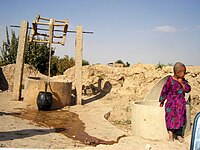
Photo from wikipedia
This paper presents a novel methodology to model semi-steady state horizontal well flow performance in an anisotropic reservoir taking into account flow in the near-well region for an arbitrary well… Click to show full abstract
This paper presents a novel methodology to model semi-steady state horizontal well flow performance in an anisotropic reservoir taking into account flow in the near-well region for an arbitrary well trajectory. It is based on an analytical productivity model describing coupled axial reservoir flow and radial well inflow. In order to apply this model in an anisotropic reservoir, the permeability field relative to the radial direction perpendicular to the well trajectory and the axial direction along the well trajectory must first be determined. A classical space transformation is used in concert with rotational transforms to obtain a virtual isotropic model. The transformation preserves the volumes and pressures. It is not a novel concept, but different from previous approaches in the sense that it is only applied in the near-well domain to formulate an equally isotropic media. As a result, the use of this virtual isotropic model requires the Dietz shape factor for an ellipse, transformed from the original cylindrical near-well domain. The Dietz shape factors are determined numerically in this research. The semi-steady state well/near-well model is implemented in a numerical simulator incorporating formation anisotropy and wellbore hydraulics. The specific productivity index along the well trajectory is generated using the virtual configuration. Numerical results for different anisotropy ratios and also incorporating frictional losses in the well are presented. Furthermore, the well/near-well model is applied in coupling with streamline reservoir model for a water flooding case. This appears to be the first coupling of a well hydraulics model and a streamline simulator. It presents the application of the well/near-well model in integrated reservoir simulation in an efficient and accurate manner. The results demonstrate that the coupling approach with a streamline reservoir model and the well/near-well is of great potential for advanced well simulation efficiently.
Journal Title: Computational Geosciences
Year Published: 2018
Link to full text (if available)
Share on Social Media: Sign Up to like & get
recommendations!